#ALSO of shapelessness
Explore tagged Tumblr posts
Text
south asian ppl being positive abt snakes > every culturally christian mf who uses “snake” to mean a “sneaky, scheming person”
#its so sad to see the snhate#also its so funny and annoying when its a new age idiot who talks about chakras and the kundilni. just like. no awareness that calling ppl#snakes obviously derives from christians demonizing those exact types of spirital beliefs which have dharmic origins need i remind you#since new age idiots seem to fuckin forget#you cant just. talk abt the kundilini and then be like 'snakes bad' get out of here nerd#go back to christianity already#proving yet again that new age shit- while somewhat disconnected from christianity- is still far too infected by it to act like its not#part of its core beliefs. id argue the majority of it is christian actually just with other hints of other religions tied onto it.#other religions none of them care to actually understand or try to respect#like if u really wanna know snakes are a symbol of fertility and sexuality and rebirth and precision. but whatever.#ALSO of shapelessness
13 notes
·
View notes
Note
Hello, Mr./Ms./Mx. Ozzgin! May I ask a really dumb question? Which one of your yanderes would accept a transmasc darling? Because I am a trans man and am kind of insecure about it, so I wanted to know who I could fantasize about to help me feel better about my body! Of course, you don't have to answer this and I am so incredibly sorry if I'm making you uncomfortable or if I'm not making any sense! Either way, I'm wishing you a very nice day! Thank you for everything that you're doing! Goodbye!
First, I'll mention that I imagine most of my characters somewhere along the demisexual spectrum. In the sense that sure, they find you cute at first sight, but they love you for who you are, irrespective of your appearance or gender. It doesn't make a difference.
That being said, I do think some relationship dynamics are more interesting than others depending on the character.
Yan!Swordsman with a transmasc Reader holds a lot of complexity in my opinion. There's a lot of historical baggage, as well as outdated views that may come into play. He would struggle a lot, especially once he falls for you.
He'd be overly protective, interrupting your sparing sessions, or hesitantly postponing your city patrols because you might get hurt. Mind you, he's particularly caring with all his underlings, but you being his partner truly exacerbates his instincts.
You may be tempted to point a finger and accuse him of not seeing you as an actual man. It's not the case. On the contrary, you being a man makes matters even less complicated: bringing a wife to the headquarters would spark outrage. Having a male partner, on the other hand, is common practice among the samurai.
Regardless of what you are, he needs to know you're safe. It keeps him awake at night. Maybe a compromise can eventually be reached; while he can't forfeit his watchful gaze on you, he can be a little rougher when you're around everyone else. Thus, your bad posture is no longer reprimanded with a scold, but with the sharp sting of a bamboo pole against your feet. At last, you're part of the family, treated like all the other swordsmen who warned you about the Captain's ruthless discipline. For the better or the worse, you think to yourself, massaging the red spots. "Are you alright," he questions with a faint smirk. "What? I didn't even feel anything," you retort, determined to prove him wrong. Don't worry, he'll make sure to spoil you later.
#yandere swordsman#yandere x reader#it's also why I never describe Reader with anything but slight personality traits#the Reader in my head is a shapeless blob filled with obliviousness to danger and sarcasm#which makes my OCs blobsexual I guess
127 notes
·
View notes
Text
I've remarked on this blog a few times before that I'm fond of the theory that The Shapeless One is Paracelsus, but I've always hesitated to elaborate, as I felt like there wasn't enough hard evidence that supported this theory being true. However, something recently clicked for me regarding one big parallel between them, and now I can't stop thinking about what that connection would mean for the story thematically.
In mémoire 61, after Machina pushes him to explain what his "plot" is, Teacher declares that he wants to achieve world peace. I've had no idea what to make of this line for a while now, just assuming that we'd need more context to understand what the actual hell he's talking about. But with the Paracelsus comparison, I feel like I'm starting to grasp what's going on there.
[This post needs a VnC-standard warning for mentions of suicide, sexual assault, and child abuse].
There are a few pieces of evidence that support the idea of Teacher being Paracelsus. VnC's Paracelsus is introduced as a great alchemist, just as he was in the real world, and the Count of Saint Germain was an alchemist as well. Nobody knows Teacher's origins, but he's one of the oldest vampires and close with the queen. There's also a little drawing of six-pointed stars that appears behind Paracelsus in the first storybook illustration of him, and those same stars are seen hanging from Teacher's walking stick in the scene where he first meets Noé.


That panel of Teacher and Noé appears at the very end of chapter 6, and the Paracelsus panel appears at the start of chapter 7, meaning these images are quite conspicuously close together.
So what does this mean for Teacher's idea of "world peace"?
In the storybook version of Paracelsus's life, he's described as wanting to alter the world formula not for scientific curiosity, but because he wants to save the world.
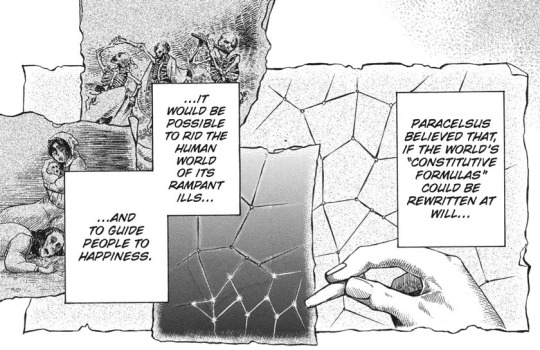
Paracelsus, per the childish version that Teacher presents to Noé, caused the Babel Incident because he was trying to "rid the world of its ills" and "guide people to happiness." The line about the human world's "rampant ills" is read over a drawing of dancing skeletons—a Danse Macabre. This is a Medieval way of drawing the personification of death, usually for the purpose of expressing the way that death comes comes for every person inevitably (the same theme later expressed by Vanitas art).
When Paracelsus speaks of the world's ills, this is the reality he seeks to cure. The world is afflicted with suffering and death, and he wants to rewrite the world's formula so that humanity can live happily without that pain.
A world rewritten to be without suffering—isn't that world peace? "World peace" is often used to evoke an end to armed conflict specifically, rather than suffering at large, but the concepts must overlap if they're pursued seriously. How can world peace last if there are people starving in famines or dying of disease? Suffering breeds violence. And how can someone seeking to alleviate "the world's ills" not want to achieve world peace?
If this is true, if Teacher's hope for "world peace" is him carrying on Paracelsus's legacy (or carrying on his own work, if they're the same man), then what does that mean for Paracelsus's supposed altruistic intentions?
We know little about Paracelsus now, only Teacher's recounting of the Babel Incident by way of a book he's reading to a child, but I think there are two ways to interpret what we do know.
Trying to rid the world of suffering is, on its face, the most noble possible intention. To lead the world to happiness is to attempt to help every other person in the world. And I can think of a lot of ways that Paracelsus's goals make absolute sense to me. If you discover that the fabric of reality can be rewritten, and you know that there are people in the world dying of famines, wouldn't you want to reshape the world so that they no longer have to go hungry?
It's possible, depending on what we find out about him in the future, that Paracelsus really will be a noble figure whose one great sin was hubris, and all he wanted from his research was to help the world in ways that make both moral and logical sense.
However, given some of VnC's other themes, I think there's another lens through which we should consider Paracelsus's actions. We don't know exactly what he was trying to rewrite with that disastrous experiment, but that Danse Macabre does give us one possible clue.
One of the themes that VnC has been slowly developing throughout its run is the idea that, though trying to save a person's life is noble, it is not noble to deny all death as a whole. This is a story about the concept of Vanitas, the idea that death is inevitable and that all else is rendered meaningless in its face. Noé feels like he failed Louis because he was unable to kill him when he asked, and it seems like the manga's being set up to end with Noé killing Vanitas to escape a fate Vanitas considers worse than death. One big part of what makes Mikhail so unsettling is his denial, his laughing about his mother's draining and the fact that he cannot accept the reality Luna has died, and Vanitas is horrified to hear that Misha is planning to resurrect their parent. That same issue goes on to be the one thing that finally drives a wedge between Noé and his teacher, as Noé can apparently forgive the man for purchasing him on the black market and killing Louis, but he's horrified to hear that Teacher told Mikhail that resurrecting Luna was possible.
All of these scenes have other elements to them, other things that drive the characters and inform why these specific ideas of undeath are so deeply horrifying to them, but the buildup of this running theme is an undercurrent through all of it. Vanitas means that someday all people must die, so what does it mean when somebody tries to deny that?
Even further, there's the broader horror of both Noé and Mikhail failing to process the bad things that happen to them. Misha commits blithe horrors in part because he does not understand that his sexual abuse was wrong, so he seems to see no problem with sexually assaulting others now in turn—as he does when he pressures Noé to drink his blood. Noé happily recounts being kidnapped and sold on the black market, remarks on Chloé and Jean-Jacques's goodness minutes after Chloé assaults him in his sleep, and brushes off the incident of Jean-Jacques drugging him to the extent that even Jean-Jacques himself is unnerved by it. All of that is deeply concerning behavior.
Misha is written to be obviously uncanny in his denial, and that uncanniness holds up a mirror to the subtler horror of Noé's own disconnects from reality. The more recent chapters have also begun drawing direct attention to the ways that Noé's denial of the bad in the world becomes problematic. The aforementioned scene of Vani, Dante, and JJ being disturbed by Noé's "it doesn't bother me" line does this, as does the long discussion Noé and Vanitas have about why Noé's ignorance of anti-Dham racism upsets Dante so much.
There is an ongoing tension in VnC between the inherent goodness of peace and life and the horror of what comes when those concepts are taken too far. Noé and Vanitas are this in a nutshell: an endlessly clashing duo made up of a too-extreme pessimist and a too-extreme optimist. The story arcs thus far have taken turns challenging each of their worldviews, slowly pushing Vanitas to open up and let himself hope for peaceful solutions, let himself accept love and emotional closeness, while also slowly pushing Noé to confront the fact that sometimes not everything has a happy-making peaceful solution after all. Sometimes "saving" a child means she has to die, and sometimes an enemy will have an entirely sympathetic reason to hate vampires, but Noé still has to fight them anyway to save the people he wants to save, regardless of whether that enemy is "right" or not.
Noé lives in denial of his own past traumas and his own present-day potential for harm. He denies the potential that "good" people he meets might harm him, and he struggles to accept instances where he has harmed others in turn. Dominique and Vanitas go on for pages after the amusement park about how reckless and overly trusting he can be, and he turns around, unable to cope, when confronted with the truth of what he did to Misha with his claws. However, Noé also has the benefit of his proximity to Vanitas knocking just a bit of sense into him, and it might not be a sure thing that he's going to stay in denial-land forever.
One of VnC's specific points of tension is the question of if/how Noé will grow to accept the hard things that currently bounce off his oblivious denial like water off of a raincoat. The end of mémoire 1, the statement that someday he's going to kill Vanitas, suggests that perhaps he might learn to understand how death, despite its pain, is important in its own right. It suggests that maybe he'll come around to no longer denying death and insisting that salvation is always its avoidance.
However, if he can't quite make that leap, the story provides us with dark mirrors to show us what a monster Noé could become by doubling down on his idealistic, optimistic denial. Misha's current state is Noé to an extreme, an innocent child committing horrors as he utterly fails to process the truth of his own horrific early childhood. Misha's driving motivation is a hatred of pain and suffering, and he's willing to do anything to resurrect the family that saved him from that pain in the past.
Then there's also Lord Ruthven, a man who was once an optimist in Noé's own mold, but has since broken bad in a spectacular way. Noé and Ruthven recite the exact same line about liking both humans and vampires, an obvious parallel, but now Ruthven is working with Naenia. Now he's living in the aftermath of his idealistic peace plan imploding and almost costing him his life. Ruthven despairs the last time he visits Gévaudan, lamenting the wrongness of his naive past hopes for understanding, and now he's working toward some unknown end involving Naenia, Charlatan, and the Queen. Now he's committing horrors of his own, biting at least three people by force, overriding their wills, and associating with the being that steals innocent people's true names.
There's also the question of what the hell Ruthven is doing with the queen. It seems he was somehow involved with Faustina devolving to her current state, and Loki references "smashing up her corpse," so it's possible Naenia's existence may be a sign that Ruthven wants or wanted her dead and/or cursed. However, the shots of him with the Faustina-like body in the tank at the end of mémoire 18 suggest there's a chance that he could instead be involved with some form of resurrection scheme (or a scheme to preserve/save her if she's not yet fully dead).
Ruthven exists in part to demonstrate the ways that an idealist like Noé can go bad, and it's possible that he, like Misha, is attempting some sort of awful resurrection, once again denying the reality of death.
Then, finally, there's one more character with whom Noé has these sorts of obvious parallels. The man who, perhaps, is also meant to represent what Noé could become if the dangerous sides of his optimism aren't reigned in: his teacher.
Noé is fascinated by Vanitas, drawn to him out of care and connection, but also because he wants to observe and understand him to sate his curiosity. In a darker mirror of the same trend, we see Noé's teacher allow Louis, Noé, Domi, and Misha to come to harm at least in part for the simple enjoyment of seeing how they react when placed in dark new situations. Noé and his teacher are also the only crimson vampires we know of who find the Blue Moon beautiful and alluring, rather than a source of fear (assuming that Teacher is a normal crimson vampire).
Noé was raised by this man; his worldview has been shaped by him in countless ways big and small. Noé was already living in cheerful rejection of trauma before The Shapeless One found him, but he could not have remained so radically detached from the painful parts of the world around him if his teacher had not wanted and allowed him to do so. He censored Lord Ruthven out of Noé's education, and he apparently did the same with anything that discussed (or expressed) severe bigotry toward Dhampirs. How else did Teacher shape him, and to what goal?
We know that the Shapeless One taught Noé how to fight. Given that "world peace" line, I wonder if perhaps he may also have taught him his morals on wanting to avoid conflict.
Teacher is a contradiction. He talks about "world peace," but he blithely leads Louis to his doom and supposedly doesn't hesitate to half-kill anyone who calls him by the wrong name. Marquis Machina calls him an incomprehensible natural disaster for this reason. Yet, despite all his rampant cruelty, I'm beginning to think that he might be just as much of a dangerous optimist as his student.
Teacher is defined by the fact that, in every scene, he always seems to look like he's having fun. There's hardly been a single panel where he's not drawn smiling. Sometimes that fun is vicious, a cruel smile made as a threat to Vanitas when he fails to address him by his name, but just as often, his aura seems horrifically innocent. He's just a man with a sweet smile and rather dull eyes having a very good time with life.
In the past I've largely looked at this smile as an extension of Teacher's sadism. He toys with Louis and Noé for the fun of it, and I took his smile as an expression of his cruel enjoyment of the pain he creates in his wake. However, now that we've seen him interact with Machina, now that we've observed him speaking casually with a peer for an extended period, there seems to be a disturbingly sincere quality to him as well.

Based on how he's portrayed in mémoire 61, when Teacher says he does everything he does for the sake of "world peace," I honestly think I believe him. I don't believe that he's not a villain—I can't guarantee that his vision of "world peace" would even align with a normal person's definition of "peace" or "happiness," but I believe that he's speaking some version of honestly here.
There's an honest to goodness optimism in that ever-present smile. There's a hope and a genuine quality to what he announces to Machina, in contrast to his smiles of sweetly cruel schadenfreude.
So perhaps, if all that is true, if Teacher is another dark mirror to Noé and he really does want to bring about world peace, then the point of him is that "world peace" has the potential to be a horror. What is the pursuit of world peace if not the ultimate pipe dream of every idealist in the mold of Noé and Ruthven? And what is VnC if not a long catalog of the horrors that idealists can bring about if they aren't careful?
And that, finally, brings me back to Paracelsus and the Danse Macabre.
Depending on what Paracelsus wanted to achieve through his experiments, it's possible he may have been yet another character trying to escape the harsh reality of death. The line about the world's "rampant ills" is placed over the Danse Macabre, after all—a symbol of death's universal inevitability. Is that the painful ill that Paracelsus wanted to address by rewriting the world formula? Inescapable death itself?
If so, Paracelsus becomes the ultimate embodiment of what happens when one denies death's certainty and the necessity of that certainty. He's the ultimate denial of "Vanitas" and what it represents on a scale far larger than Noé, Misha, or even Ruthven could grasp. And the manga casts his failed experiment as a Tower of Babel, throwing the world into chaos and causing countless deaths in his failure's wake.
Meanwhile, Teacher seems to have some ideas about how to cheat death in the present day, as he's promised Misha that there's a way to bring "The Vampire of the Blue Moon" back to life. This could be a lie, of course, or he could be planning to bring back "the vampire of the blue moon" in a way that does not actually bring back Luna as an individual. However, even trying to bring back the Blue Moon in some other way, perhaps through the human Vanitas, still represents him trying to restore something he found beautiful that was lost because of death. It still ties him thematically to the perversion of death as an ending, the same as Mikhail and Ruthven.
So far every character we've seen that wants to undo death is cast as an antagonist. Ruthven, Mikhail, and The Shapeless One are all united by a cruelty and a perverseness in various forms, and their goal is part of this. Death is a tragedy, but although trying to save the lives of people who want to live is noble, attempting to undo or eternally escape death is a far worse horror.
If Teacher is Paracelsus, or if they're closely connected in some other way, then that serves to further this point and show how the horror of escaping death extends to Paracelsus as it does the others. Teacher is strange and cruel. Paracelsus might be a nobly hubristic historical fool in a storybook, but if these two characters are connected, that instantly reveals the unsettling truth of how wrong Paracelsus's potential attempt to thwart death would have been. Nothing Teacher is working for can be wholly good.
And, just as Noé and Misha's denial is both present and harmful beyond the most severe subject of death, even if Paracelsus wasn't trying to craft a world without death by altering the world formula, we know he was trying to create a world without suffering. Again, this is a noble goal in theory, but so long as death remains, some suffering will remain as well. Crafting a world without pain and suffering can also go much too far, can slip into denial and cruelty. Mikhail's whole motivation as an antagonist is his search for a life without pain, and look where that's led him.
A rejection of all suffering can be an extremely dangerous thing, whether it's running from one's own mental pain or wanting to rewrite the world to negate all suffering as a whole. This dream will never not be a detachment from reality.
The Case Study of Vanitas is a series that seems to be searching for a balance of optimism and pessimism, a way to approach the harsh realities of life that lies between the toxic extremes embodied by Vanitas and Noé. To lapse too far into hopeless pessimism creates a Vanitas, a Chloé, an Astolfo. It creates people who are suicidal, genocidal, or both, and dangerous to themselves and others for it. However, to go through life in a state of eternal joy without processing one's pain, or to attempt to create a world wholly free of suffering—that is just as dangerous and foolish. What are Noé, Misha, and Ruthven if not dangers to themselves and others? What is Teacher if not the most dangerous man in this manga?
Noé and Misha are unsettling because they smile through the bad things that happen to them and act as though they aren't bad. They each have some exceptions to this rule—Louis's death for Noé and the pain suffered at the hands of Moreau for Misha—but they still come across as at times disconnected from the reality of pain.
Yet, neither of them is as disconnected from the reality of pain as a man that can behead the grandson he raised with a smile on his face. Noé as a child sees the fun in being kidnapped and put up for auction. Teacher, if his smile is to be believed, sees the fun in every single thing we've seen him do, and that's what's so unsettling about him. He genuinely seems to be having a good time, including and especially when he's blithely committing horrors for the fun of it.
Noé and Misha's strange behavior stems from trauma, and we don't know that's the case for Teacher. Perhaps not, as he seems much colder and crueler in his tendencies than either of them. But either way, the happy sincerity displayed by both of them is echoed in the face of the Count of Saint Germain as he tells Machina that he's searching for world peace. That is the face of someone idealistic, someone who believes he's working toward a real goal that both justifies and delights him.
Teacher wants world peace, and his warped nature means that we have no real idea what "world peace" means to him. Is a world at peace a world where he still gets to violently beat people who get his name wrong? A world where he still gets to have fun observing the free will and choices of the traumatized children he raises? Maybe he once believed in a world that was truly without suffering, and his overly-long life and mad optimism have eroded his tether to reality, turning him into the awful person we see now. Maybe the catastrophe of the Babel incident broke him and turned him from a hubristic idealist to warped echo of his former self. Maybe he somehow thinks all the suffering he causes is justified if it's in pursuit of his noble end goal. Maybe his version of "world peace" is a world where all people can live free from the fear of death, and the smaller pains caused along the way are irrelevant in the face of that impossible dream.
Or maybe he's just a cruel hypocrite.
In the end, we still know too little about both Paracelsus and Teacher to make any grand proclamations about the truth of their characters. However, I can't unsee this connection between them now that I've seen it. Teacher is one of Noé's dark mirrors, a character that represents the horrors possible when one goes too far down his current emotional path. Noé is optimistic to a fault, convincing himself to see only the best in many truly awful scenarios, and Teacher is the man with an eternal smile printed on his face. Noé loves and wants to save Vanitas, and Teacher speaks of the Blue Moon's ultimate beauty and says he has a way to bring them back to life now that they're dead. Noé is the eternal savior, always desperate to prevent people from dying, and Teacher claims that everything he does is done in the name of achieving world peace.
Similarly, Paracelsus is defined by throwing the world into chaos and horror due to his over-optimism. He tried to go too far, tried to rid humanity of its countless ills and create his own form of world peace, perhaps even tried to rewrite the reality of death. Did he hate pain and cold like Misha? Did he want to stop unjust wars like Ruthven? Did he want to become a savior in the image of Noah?
If Teacher's goal of "world peace" is to be believed, then whether or not Teacher and Paracelsus are actually the same person, they represent the same thematic extreme. Death is inevitable, says the concept of Vanitas. It's inevitable and Noé must learn to accept that fact before he does something awful in the name of pain and death's prevention. Teacher and Paracelsus have both done something(s) awful in the name of pain and death's prevention. Teacher and Paracelsus have followed Noé's path of optimism to such an extent that they, in one way or another, both claim(ed) to want to save the world, and this requires a mad extreme of Noé-like cognitive dissonance and hubris.
Paracelsus pursued some goal, some way of granting humanity happiness that was supposedly noble but still murky in its specifics, and he warped the fabric of reality and caused the countless disasters of the Babel Incident in the process. And that's assuming the storybook is true, and Babel really was accidental on his part. Meanwhile Teacher has warped the seemingly noble dream of world peace into something that he can claim is served by the way he's tormented Louis, Misha, and Noé. There's a chance that both men tried or are trying to undo the reality of death. They're bound by the same underlying current of scientific curiosity intermingled with their dreams of world peace.
Noé is not an alchemist, and he's not particularly skilled at rewriting the world formula. He's unlikely to have any chance to rewrite the fabric of reality itself for the better. He's unlikely to have any chance to achieve "world peace" by any definition.
Noé is, however, a dangerous optimist who has not yet learned that death is unavoidable. He hasn't yet learned that death can be preferred to its alternatives. And he was raised by a man who seems like he has not learned or does not care that disrupting Death in the grand sense will inevitably lead to horror. Or perhaps a man who enjoys horrors and wants to toy with absolute death as a part of that. And all this in a world warped and defined by the folly of a man who may also not have understood the horror of evading death.
So Teacher might be Paracelsus. I think this connection between them only strengthens the odds of that theory being true. But even if he isn't, they represent a similar thing for Noé and for the manga's themes at large. You cannot rid the world of the Danse Macabre, and attempting to end that dance will only bring greater ills and greater pain than death on its own could ever hope to bring.
A strange and dangerous man proclaiming with an honest smile that he wants to bring about world peace does not make him any less strange or dangerous. Depending on his definition of world peace and his idea of death's place in it, that idealistic goal may actually make him far more dangerous than if he were nothing more than a simple sadist.
#I've talked at length about some of these ideas in other posts before#but putting this together felt like finally being able to marry a few different major themes I've written about#that have stayed largely disparate up to this point#also huge shoutout to the several other theorists I've seen point out the thing with teacher and paracelsus and the stars#that's such a cool detail#ANYWAY this is more of a reach than what I'd usually stake a whole meta essay on. but I feel like my thematic foundations are sound#vnc#vanitas no carte#the case study of vanitas#teacher#vnc teacher#the shapeless one#comte de saint germain#vnc paracelsus#teacher my beloathed#noé archiviste#theory#english major hours#vnc spoilers
119 notes
·
View notes
Text
I’m a pretty tall cis woman with narrow hips, which means that now and again if my hair isn’t visible (eg under a hat) I get misgendered from behind. This doesn’t bother me but typically results in the other person looking mortified the instant I turn around.
Anyway yesterday was the first time in my life I turned around to someone looking deeply uncomfortable who then doubled down on calling me sir, and again I’m not precisely bothered by this but I am extremely curious about what was going on there.
#genuinely could not tell if they were trying to be polite or one of those unhinged transphobes trying to reinvent phrenology#granted i was in quite a shapeless winter coat but i also had my (very long) hair down and dangly earrings in#and i have fairly quote unquote feminine features or so i am told. so????? i’m so curious lol#gender stuff#my posts
30 notes
·
View notes
Text

I'm very tired of how bad/incomplete all the wikis are for Farmer's Delight, so I guess now I'm working on my own set of infographics. Starting with a lot of very repetitive editing in Photoshop!
#salem tag#farmers delight#modded minecraft#i cant wait until I get to work on making things pretty and I'm out of Get All The Images You Need hell#also yes the Cooking Pot UI is edited - it took up way too much space and was needlessly confusing for learning purposes#i removed the arrow and the ladle symbol and the 'output' spot and then shifted the bowl/bottle area below the output#technically crafting is also edited bc I removed the arrow and seriously shrunk the window#I still need to figure out good ways to indicate potion effects/duration and to indicate Shapeless or Shaped crafting
218 notes
·
View notes
Text
[blows a kiss out to sea] for the Mighty Nein pirates arc
#I'm!! I have so many thoughts about why this arc is SO GOOD#But the short version is like#It is an arc about Fjord and identity and power and self and agency as he faces the truth of his patron and faces a rival warlock#But it is ALSO about Fjord grappling with those things bc he is ALSO processing grief and sadness and a search for direction and purpose#and grappling with disappointing disillusionment in how the world and people in your life (including maybe yourself) isn't what you thought#and about coming to resolve he has the agency and strength to not allow these things to deter him from purpose and place in the world.#And—this is why this is a PHENOMENAL arc—so is the rest of the Nein. Individually and as a group.#All of them are grappling with feelings of grief and sadness and disappointment and directionlessness and helplessness#just the grand malaise and relentless shapelessness of what living often is#They also as individuals and as a group together also find that resolve and strength to carry on and find self and purpose and direction#They all begin to process the very same things in their own lives and in their shared experience as The Nein. Simultaneously and together.#It's an arc about Fjord and self and agency in the face of disappointment and grief and disillusionment.#It's an arc about the Nein—individually and as a whole—and self and agency in the face of disappointment and grief and disillusionment.#It's SUCH a strong arc bc ALL of them are taking the same internal journey—structured around Fjord's very externalized version of it.#And it's got incredible vibes (pirate warlocks of a leviathan!) and some GREAT set pieces. And every NPC in the arc is iconic as is Twiggy.#Anyway. In my feelings about this arc. I said this is the short version and yet.#Critical Role things#CR meta
208 notes
·
View notes
Text
I'm obsessed with the GLOWUP of Joan's wardrobe over the seasons, & I'm finally TALKING ABOUT ITTT-
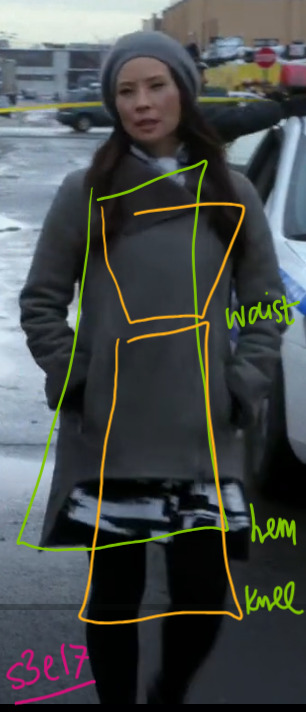

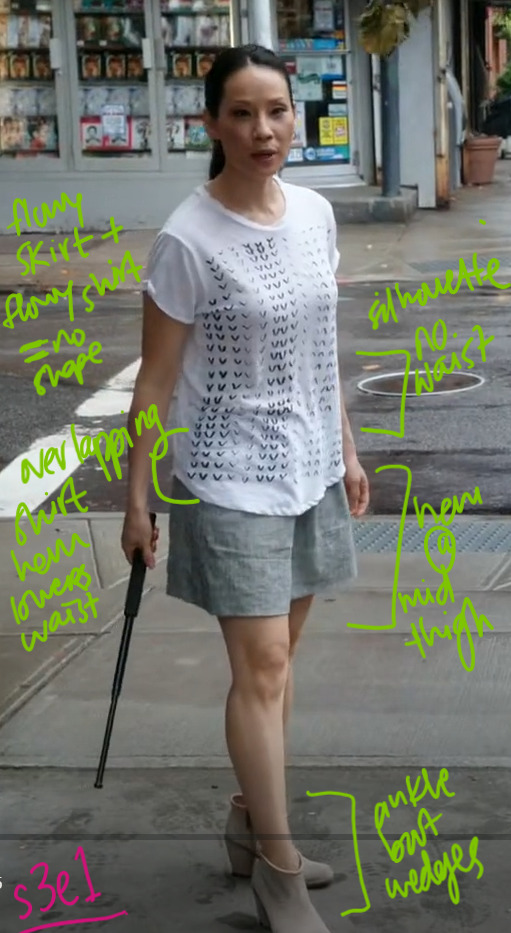
-Season 1-3 costumes rub my hair the wrong way. LOL
Lucy Liu (love her) has a longer torso and shorter legs proportionally. The clothes given by the costume/wardrobe department are flowy shapeless skirts that hit mid thigh. Along with T-shirts, basically, that are ALSO shapeless and NOT tucked in, which means her shirt hem is worn OVER her skirts and therefore visually LOWERS her waist line, making her legs look even shorter.
and don't even get me sTARTED on her ankle booties, I HATE THEM WITH A PASSION! They cut her leg off at the ankle, which becomes a double whammy in shortening her legs again!
It just does NOTHING for her silhouette. /tears out hair/ In the first pic above, I outlined in orange a silhouette that would work better for her than the green outline.


EXHIBIT A, above! Silhouette comparison: s1e9 VS s2e13 rare gold star costume. See how the shapeless polka dot does nothing for her frame? It's also incongruous as a character choice: why is Joan Watson wearing a shapeless pajama sleeping shirt with starched stiff shorts over black leggings and shiny leather booties? Where would she go in this randomized outfit, what would she be doing wearing this??
It just doesn't make sense bc Watson is professional. She's smart, she's keen, and she's not neglectful over her appearance. Even/still as a sober companion! The SECOND picture (from s2) is a rare gold star in the earlier seasons, and it's for a stakeout at a fundraiser, it's perfect! Form follows function, so of course Watson dresses up for a gala. It also proves she KNOWS how to dress her body and her proportions. Look, she actually has a waist! AT her natural waistline! If she looks so great there, why does she look so bleh another day? le sigh
-So let's look at GOOD silhouette examples, s4 and on:


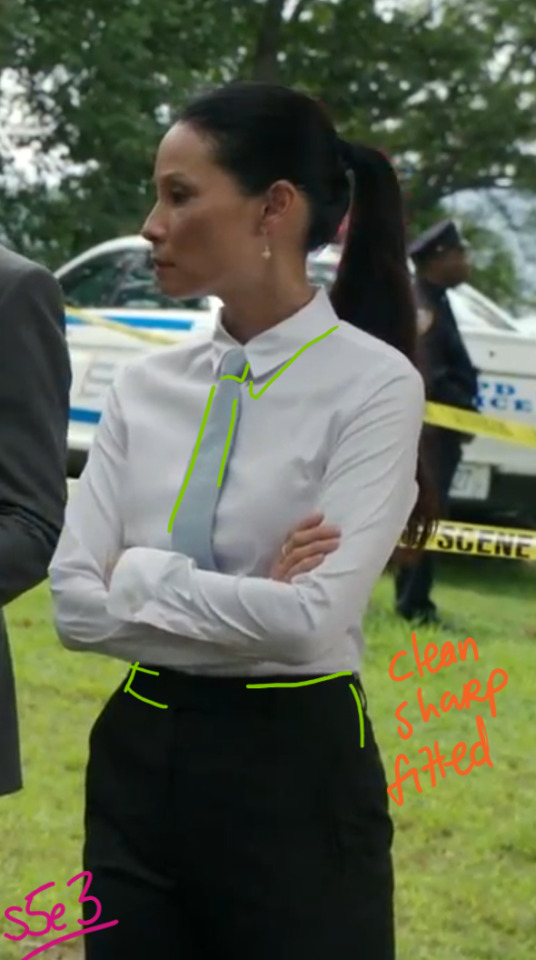
Costume dept finally SHARPENED up her look. Her clothes are fitted, sharper, with cleaner shapes. Her skirts are now mostly high-waisted pencil skirts that hit below the knee (tea length) with a tucked-in top: it's perfect for her body type! The tea length is also more professional as a character bc it gives a bit more sophistication and maturity, more 'credence' visually as a detective. For pants, they give her high-waisted fitted pants AND spiffy palazzo pants, it's so good.
Even a simple sheath dress is spiffy bc it's nipped in at the waist, so it still gives her a simple clean shape, rather than the voluminous flowy shirt/skirt combos from seasons past. My FAVORITE is when they give her tiny ties! HEHE. she wears a short fat red tie so good I screenshotted once but cant for the life of me rmbr which ep!!
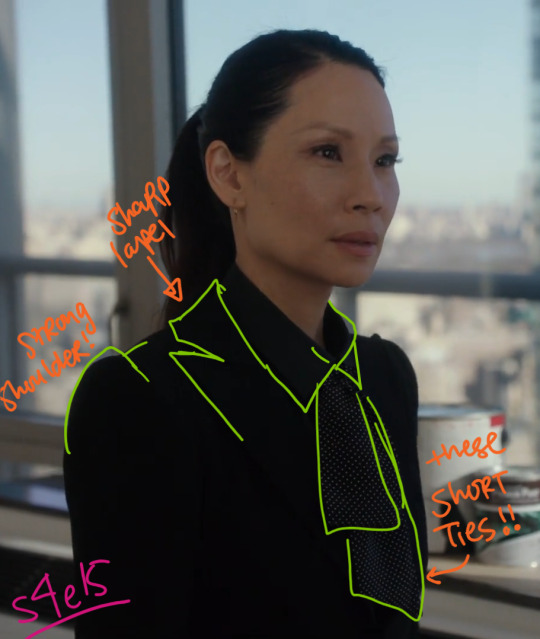
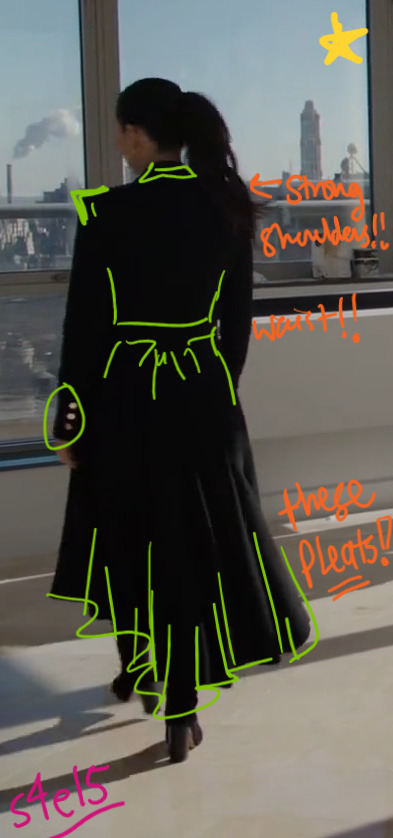

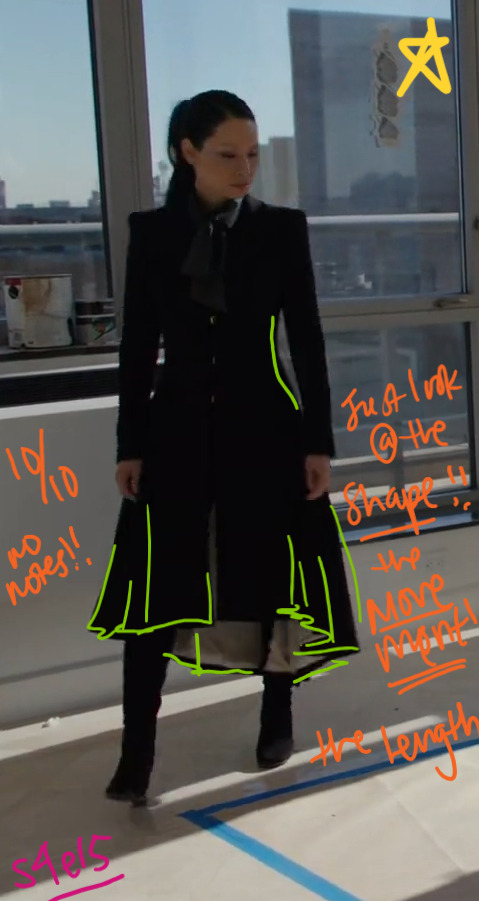
SHOUTOUT: Look at this jacket!!!!!!!! I need to say it's s4e15 so you can go WATCH IT IN MOTION; IT MOVES SO WELL!!
The flared bottom, the length, the pleats, the gather at the waist, the LINING THAT PEEKS THROUGH AT THE BOTTOM?!?!, the strong shoulders, the sharp lapels, the SHAPE of the jacket is just impeccable. It's such a GOOD choice bc it's a strong statement piece, and Joan is a strong character who can go toe to toe with Morland, spies, murderers, Moriarty, and come out on top. So she deserves this jacket.
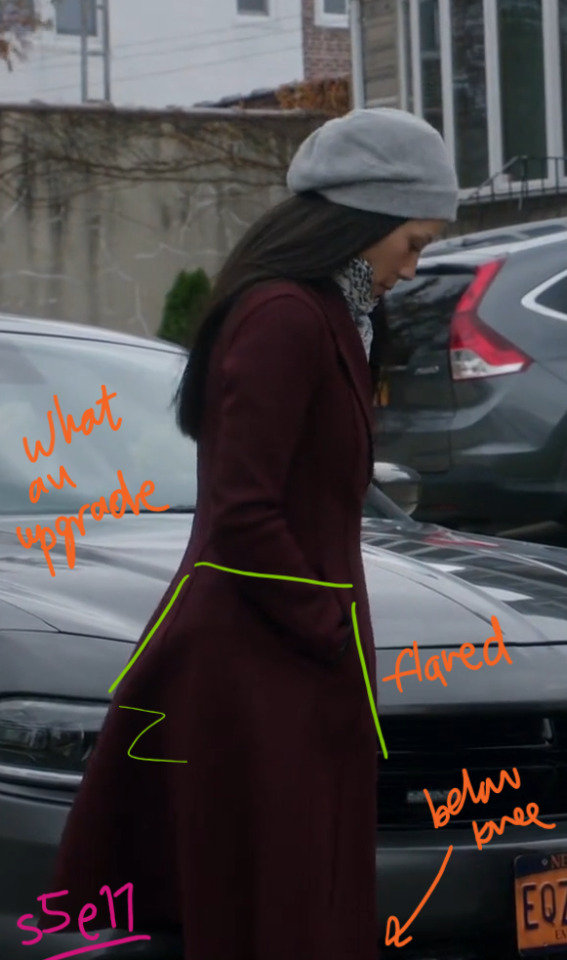
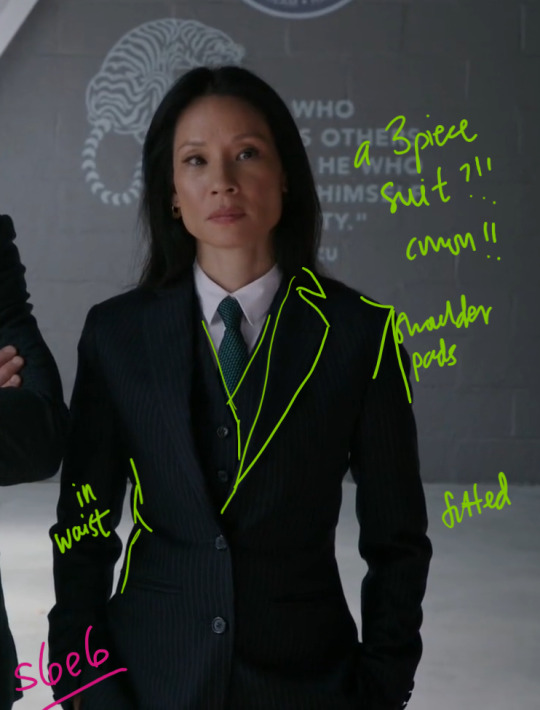
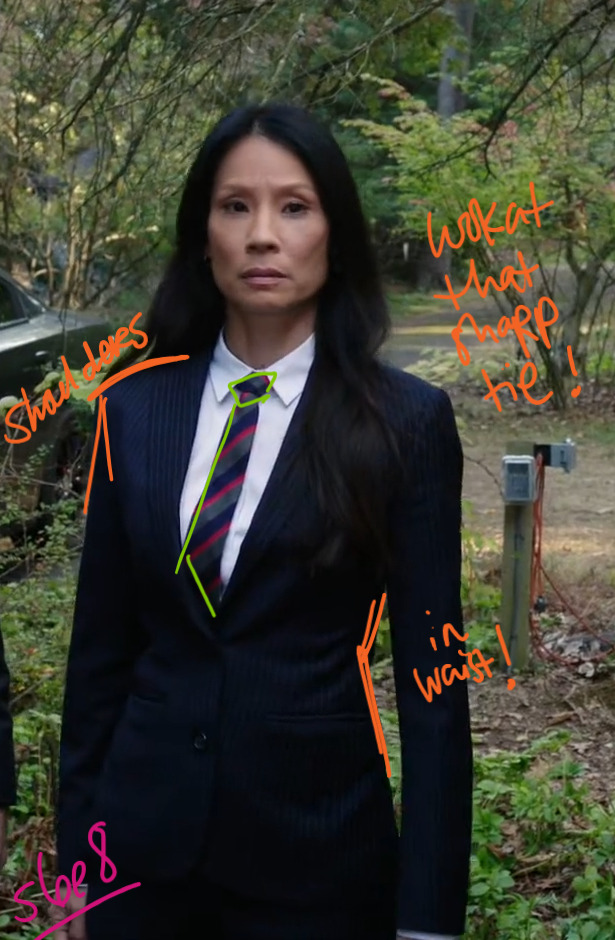

Post-s4, they also start giving her a LOT more TIES with every outfit. Whether it's a full on suit, or a short-sleeved button-down, or a cravat or a loose neckerchief. Fabulous and sharp. A great accessory that adds color and prints.
And look below! Even a simple patterned sweater can be fitted and sharp and still intentional as a costume. She can do casual without doing shapeless T-shirts. S1-3 felt like it lacked intention, neither here nor there like they didn't know which direction to go exactly, but s4+ looks intentional, not only sharper, but actually has a direction, a shape. AND look, they reuse certain pieces!!! That jacket from s5e15 to e24 season finale!!! Love it!
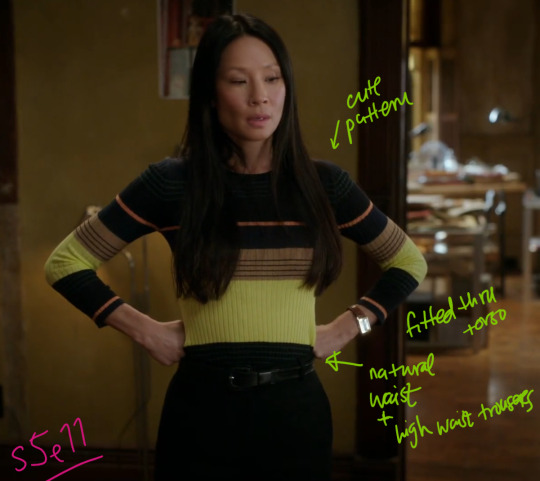
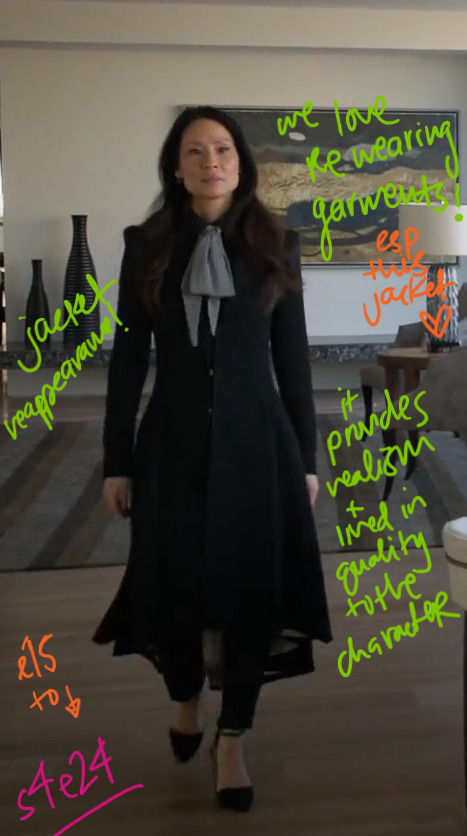
So do those s1-3 wardrobe choices inform/are necessary for her CHARACTER?? ......Not really imo, lol.
When Watson switched to work officially with Sherlock as detective, or when she established her on practice all within the first 3 seasons, her wardrobe didn't change. Her costumes still were flowy, shapeless, low-waistline outfits; that didn't change as her phases of life/professions changes. IF those shapeless costumes were intentional, then wouldn't it reflect her character's transitions? They didn't really, and arguably, s1-3 had her biggest life transitions!
BUT PRAISE BE TO SEASON 4 AND ON, bc the changes are significant, impactful, intentional, experimental, aaaand visually flattering LOL.
Anyway, 💖 lucy/watson and 💖 to COSTUME DESIGNERS, SET COSTUMERS, WARDROBE SUPERVISORS, KEY TAILORS!
tldr, TY wardrobe dept for FINALLY getting her outta those flowy shirts and skirts from s1-3 that gave her NO silhouette ough didn't do her proportions or legs any justice
#im sry but i hated her outfits s1-3 bc those dam shapeless garments did NOTHING for her#just bc she has long torso w shorter legs doesnt mean you cant DRESS her to elevate her proportions!!#AND YES it could represent her character growth#but! by season 3 shes already blossomed#shes her own detective established herself and survived sherlock being away#so realistically her growth in wardbrobe could also have happened s 2 to 3#elementary#joan watson#lucy liu#sherlock holmes#jonny lee miller#i spent all night making these screenshots lol#ok i finished writing this long ass post and just found finally the costumer designer name#rebecca hofherr#turns out shes been with elem since s1 2nd ep#interesting bc i was wondering whether the designer changed for season 4 lolol#tho to be fair to the earlier seasons#it was during 2012 ish and those werent the most stylish years#so as matter of fact it indeed was contemporary and reflected the styles of that time lolol
13 notes
·
View notes
Text
the new pjo tv series has got me thinking about pjo again,,,, augh I want to make another OC now
imagine a child of tyche whose whole thing is just video gaming. like, they’re just unnaturally lucky. the rare 0.01% drops that people spend hours grinding to get? they find them first try. playing genshin and trying to wish on a particular banner? yep, first try. they’re doing a minecraft speedrun and dig down and immediately find a stronghold.
#my ocs#percy jackon and the olympians#percy jackson#pjo#<- I forgot what tag I used for this series so I’ll just use them all just in case#like I haven’t thought of name/backstory/gender yet. they’re just a formless shapeless gamer to me and I love them.#what if they were like a twitch steamer or something… that would be so funny#I know that technology attracts monsters according to pjo lore but there’s also a child of Apollo that’s canonically a popular YouTuber so..#yeah idk maybe there’s a way around it#Annabeth also has a laptop and cell phone so there’s also that#granted the laptop was like Daedalus’s and made out of celestial bronze or smth but it’s whatever. maybe Hephaestus has a tech store.#maybe they’re just so lucky they avoid the monsters
63 notes
·
View notes
Text

this is not the point I was making omg I’m saying the general public does not understand the labor processes of the way clothes are made and therefore do not understand why designer clothes are priced that way. the way people talk about quiet luxury and say it just looks like regular clothes like actually that’s not the truth Ellen. I’m not trying to pressure people into thinking you have to buy designer 😭 like I’m just trying to make people think about the real cost of their clothes and to be less consumerist!
14 notes
·
View notes
Text

selfie i took at the therapist's office today ... need to find a new one now + a psychiatrist too.. blegh! but on we go.......
9 notes
·
View notes
Text
just thinking again about the difficulty of achieving actual escape velocity from the womenswear standard of Pervasive Negative Ease…
#an extremely 2015 post brought to you by an extremely 2015 experience#namely 'someone i follow posting an outfit pic with vibes describable as ~dapperqueer~'#except that like. the trousers were by menswear standards pretty noticeably too tight#which is something i used to notice all the time with transmasc* outfit bloggers back in the day—#just that like‚ esp by comparison with the rest of the outfit‚ the pants would just be disproportionately painted on—#and like. idk. on an individual level you Gotta not hyperscrutinize people's individual choices. you just Gotta.#but systemically it just really points up like.#a way in which 'girls' get trained to shy away from ever wearing anything that might visually bulk up their body#such that their perceptions of what 'fit' means become totally skewed#by comparison with any standard that respects like. freedom of movement for both you and the fabric you're inhabiting#ditto the way so many knitters make these intensely Shaped and frankly shrunken sweaters#and like. idk. that's not my style‚ i love a good british-fisherman shapeless sack look‚ but you do you!#but like. do you not want‚ like‚ enough room to at least fit a shirt under??#but like. the body Must Be Contained.#anyway obviously it's hard bc like. lord knows with trans fashion you're always like. trying to strike a balance between things that Fit#vs things that like. seem to you to help create a gender-affirming visual illusion even if they're in material tension with your body#(and also like. 'nonbinary' isn't in fact 'just doing the Opposite thing'! the freedom to pick and choose is part of the point!)#but at the same time. on a broader level. Patterns Do Emerge…#anyway really i'm just mad bc i'm thinking abt like. clothes i bought in too small a size#bc of my bad mind-warping training#and how i'm STILL‚ even now‚ struggling to accept eg the birk size that all metrics agree i should be#because something in my brain is like. wow those sure are some boats down at the end of your hairy calves!#which is making me feel murderous bc like. i love my leg hair passionately actually! and i deserve to have room for my toes to wiggle!!#like. goddamn. can we take up space!!!#anyway. like i said. some *extremely* 2015 nonbinary feminism feels…#(probably a bad and humiliating post to make but what is a perblog for if not. bad and humiliating posts.)
3 notes
·
View notes
Text
God it just hit me.
Names are power in VnC. We call the piece of the world formula that defines a vampire their "true name." Learning and altering a vampire's true name gives you near-absolute power over them. Vanitas hides his old name as part of his "Vanitas" persona—a defense mechanism to hide his vulnerable self.
And names are an axis of discrimination too. The main way we've been examining discrimination against the dhampirs is through the lens of vampires refusing to call them by their names. And Luna, the perennial outsider, seems not to have been given a real name. They certainly didn't have a name that they liked or identified with for most of their life.
So with all that context, even more than it might be in another series, Teacher's whole name shtick becomes such an insane power move. He changes his name constantly and will brutally punish anyone that gets it wrong. Nobody has the power that would come from knowing whatever his first/true name was. He has the physical and social power to punish and correct anyone that doesn't call him what he wants to be called. He is in complete control of how people address him, or at least close to complete control, which is such a big deal within this story.
#this was just gonna be a post about how it's interesting that names are the vehicle through which dham discrimination has been emphasized#and then I thought of teacher when I was thinking of counter examples#and then this hit me like a bus#if power comes from knowing someone's true name. and safety comes from hiding it#and calling someone what they want to be called/calling them their name is a sign of respect#teacher's found a way to ensure he gets all the safety AND all the respect#(if only out of fear)#also I realize me calling him teacher through this whole post might be a little ironic#but at this point it's just automatic#vnc#vanitas no carte#the case study of vanitas#vnc spoilers#vnc 62#<<not super directly. but with the dham name thing#english major hours#teacher my beloathed#comte de Saint Germain#the shapeless one
303 notes
·
View notes
Note
hiii kaly!! thank you for showing me love and deepspace :3
which guy is your fav? I'm guessing zayne based off your game profile lol
sajkgfakjhgdfkjasd Normal amount.
I do love all the guys, it must be said. But yes, Zayne is my favorite!
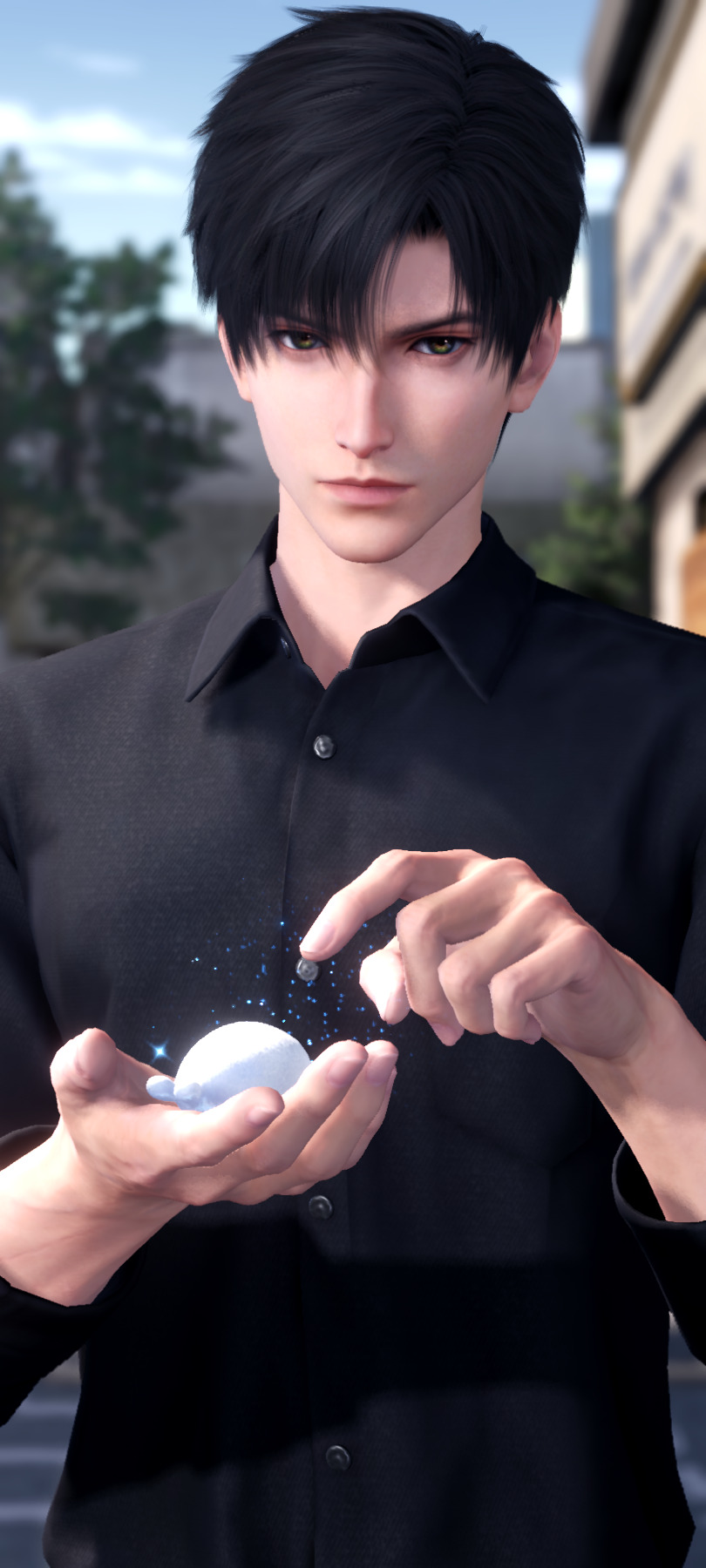

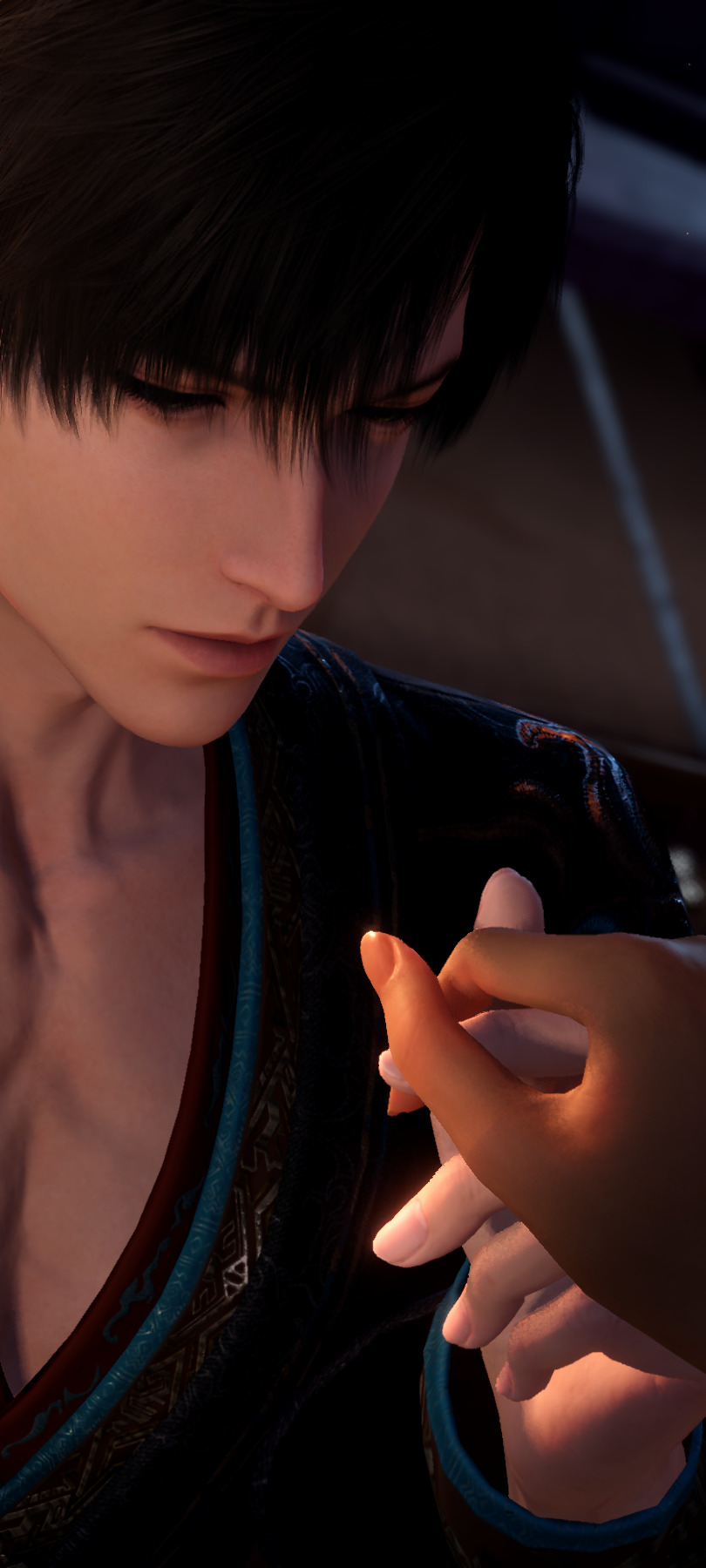
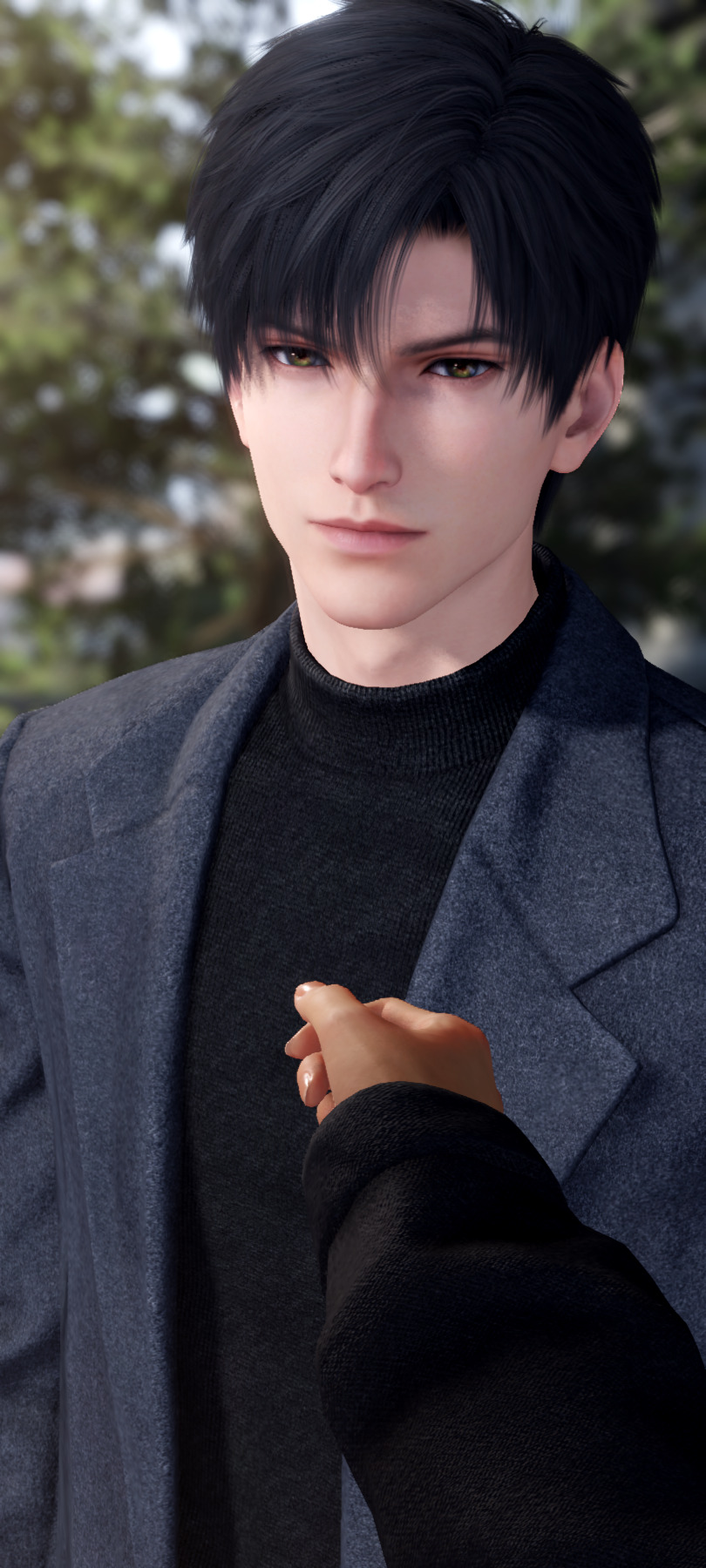

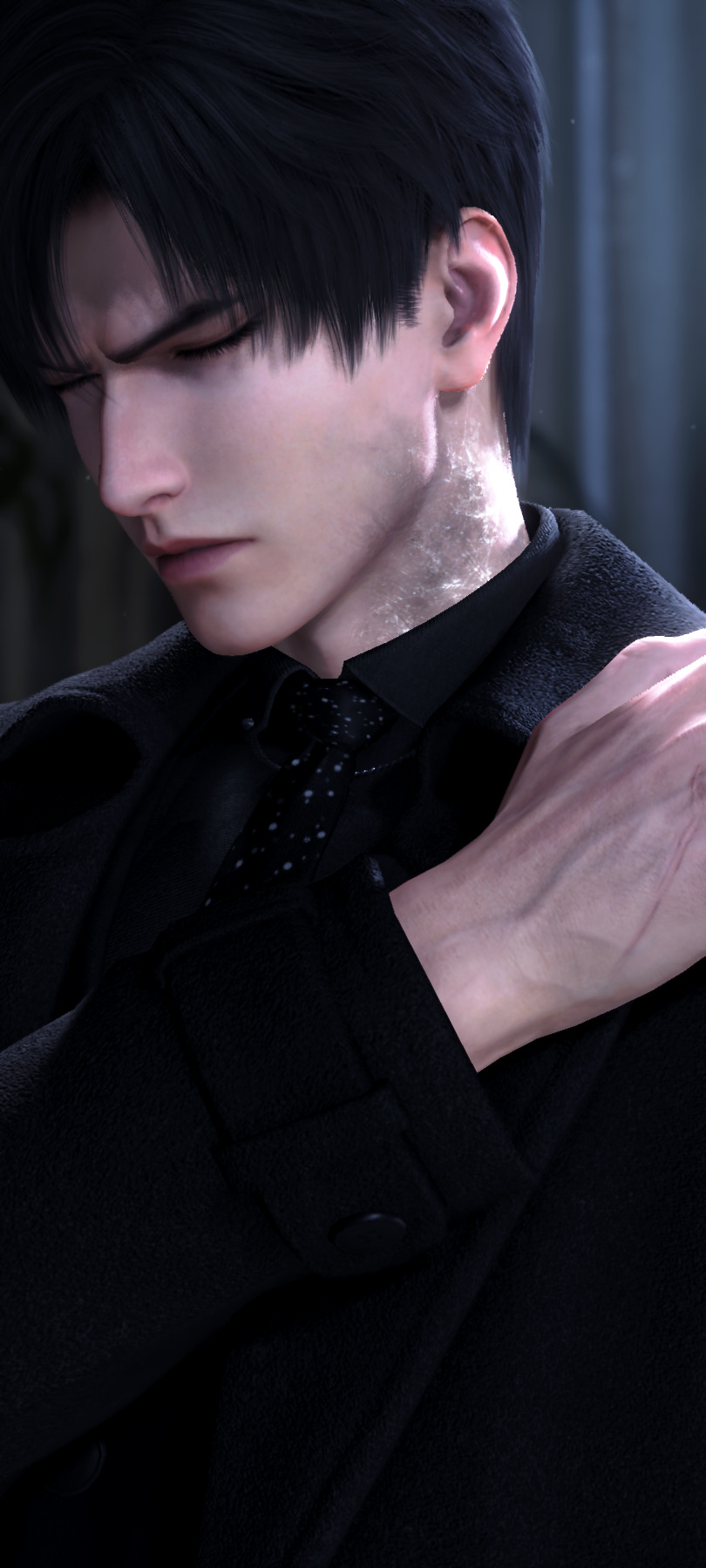
I hope you're having a good time with it!
#love and deepspace#scocophobia tw#i've written three fics so far that are just simple reimaginings of things from the game#two of them are sylus' memories but zayne features in one. and another is zayne centric because i wanted to yell at him a bit#give him a harder time than the canon mc does. you know?#been deciding about a first kiss for him and my oc / mc faedolyn (they/them) since#watched his memoria(s? is the plural memorias?) that were in limited wishing pools that have ended the past two days#so i have canon moments to work from / work with#also i hate that grey coat in the 4th screenshot. big shapeless blob#i like his coats that have belts much more
10 notes
·
View notes
Text
// as my single activity of the day i'm dropping some tags in my endless fight with tumblr to not eat them and let me use them in posts without manually copypasting please don't look at me
#〔 a.c . 〕 ϟ activating combat mode .#〔 zoroark . 〕 ϟ i've become shapeless ; now taste your own divine .#〔 y.g.o . 〕 ϟ you’re still fighting for your life .#please just keep my fucking tags i am begging#also none of you are gonna get these references
5 notes
·
View notes
Text
very tired but our parents are still awake meaning we can't sleep on the couch yet.
we need to sleep in the living room due to the window unit.
our room is still hot and our tiny fan still won't work.
#not tagging myself#i have decided that i want to snuggle but only in my metaphysical void form but also i can't because [gestures to vessel]#kat for the love of god stop calling it vore#cw vore#the flesh bags are what's throwing me off and making this worse#i feel like wearing our hoodie could semi mimic the feeling of being shapeless#but again it's hot
2 notes
·
View notes
Text
another reason it's not vacuo is because like
they actually have assets for what vacuo looks like, if they wanted us to know it was vacuo it would actually look like it
it doesn't, it's just vague shapeless nothing

#i just love the implication that it makes more sense for rwby to just#forget they almost got trapped in cyberspace by a villain from another universe#for days and weeks#knowing that he was working with someone in remnant#and only remembering that was a thing AFTER getting to vacuo#at which point they hopped back into the same simulation#and not even changing for the scorching desert climate#because trailer shots of Weiss in the part 2 trailer show her in Atlas gear in the forest from the beginning of part 1#someone explain that to me#also gonna reiterate that the reason it's not Vacuo is because the other portals we've seen were actual specific locations#not shapeless brown and blue mush#Justice League x RWBY
29 notes
·
View notes